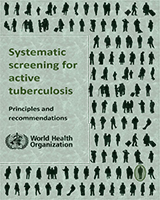WHO has developed guidelines on systematic screening for active tuberculosis (TB) based on a thorough review of available evidence. Early detection of TB is essential to further improve health outcomes for people with TB, and to reduce TB transmission more effectively. Systematic screening in high risk groups is a possible complement to efforts to improve the patient-initiated pathway to TB diagnosis (that is, diagnosing TB among people who actively seek care with TB symptoms, also called “passive case-finding”).
The available evidence suggest that screening, if done in the right way and targeting the right people, may reduce suffering and death. However the review also highlights several reasons to be cautious. As discussed in detail in this document, there is a need to balance potential benefits against the risks and costs of screening. Some risk groups should always be screened, whereas the prioritization of other risk groups as well as the choice of screening approach depend on the epidemiology, the health-system context, and the resources available.
This document sets out basic principles for prioritizing risk groups and choosing a screening approach. It emphasizes the importance of assessing the epidemiological situation, adapting approaches to local situations, integrating TB screening into other health-promotion activities, minimizing the risk of harm to individuals, and engaging in continual monitoring and evaluation.
The designations employed and the presentation of the material in this publication do not imply the expression of any opinion whatsoever on the part of the World Health Organization concerning the legal status of any country, territory, city or area or of its authorities, or concerning the delimitation of its frontiers or boundaries. Dotted lines on maps represent approximate border lines for which there may not yet be full agreement.
The mention of specific companies or of certain manufacturers' products does not imply that they are endorsed or recommended by the World Health Organization in preference to others of a similar nature that are not mentioned. Errors and omissions excepted, the names of proprietary products are distinguished by initial capital letters.
All reasonable precautions have been taken by the World Health Organization to verify the information contained in this publication. However, the published material is being distributed without warranty of any kind, either expressed or implied. The responsibility for the interpretation and use of the material lies with the reader. In no event shall the World Health Organization be liable for damages arising from its use.

